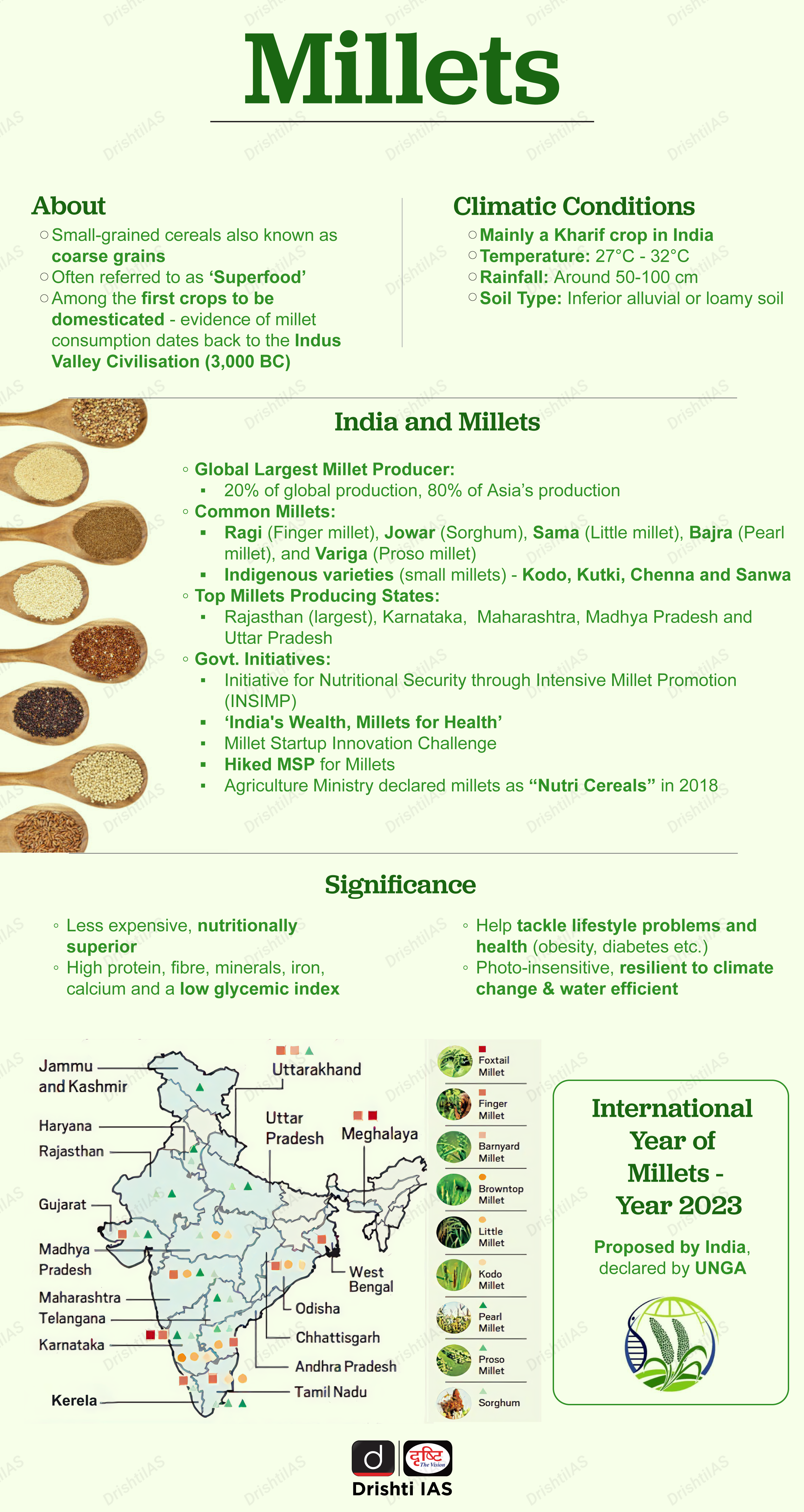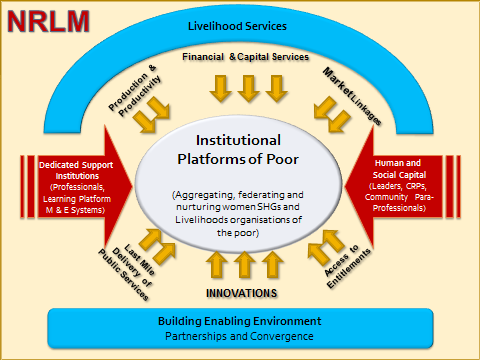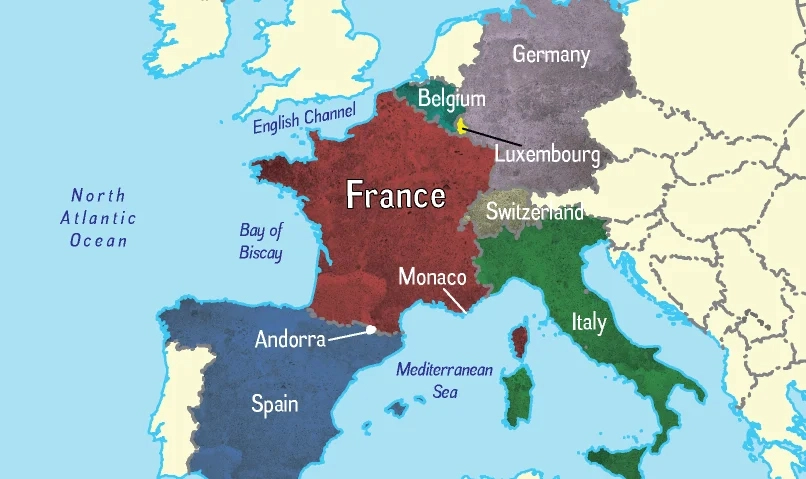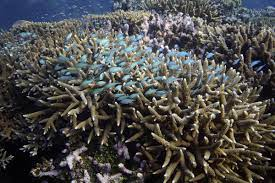Infographics
Biodiversity & Environment
State of the Climate in Asia 2021
For Prelims: The State of the Climate in Asia 2021, World Meteorological Organization, ESCAP, flash floods, cyclone, lightning, sea level rise, La Nina, mangroves
For Mains: Issues related to increasing disaster and steps need to be taken
Why in News?
Recently, the State of the Climate in Asia 2021 report was published by the World Meteorological Organization and the UN Economic and Social Commission for Asia and the Pacific (ESCAP).
What are the Findings of the Report?
- Floods and storms accounted for 80% of the natural disasters that struck Asia in 2021.
- Asian countries incurred financial losses worth USD 35.6 billion in 2021 because of natural disasters. Flooding was the event with “by far the greatest impact in Asia in terms of fatalities and economic damage.”
- This showed that the economic impact of such disasters is on the rise compared to the average of the last twenty years.
- India suffered a total loss of USD 3.2 billion from flooding and the country faced heavy rains and flash floods during the monsoon season between June and September 2021.
- These events resulted in about 1,300 casualties and damaged crops and properties.
- The country was only second to China in the Asian continent in this regard.
- Similarly, storms also caused significant economic damage, especially in India (USD 4.4 billion), followed by China (USD 3 billion) and Japan (USD 2 billion).
What are the Reasons for these Disasters?
- Arabian Sea and Kuroshio Current's Rapid Warming:
- Due to the Arabian Sea and Kuroshio Current's rapid warming, these regions are warming three times faster than the average global upper-ocean temperature.
- Ocean warming could contribute to sea level rise, alter storm paths and ocean currents and increase stratification.
- Upper-ocean warming is important because it directly affects the atmosphere in terms of convection, winds, cyclones and so on.
- The deep ocean does not affect the atmosphere directly.
- The Arabian Sea is unique because it has pathways to receive excess heat through atmospheric tunnels and bridges and mixed warm water from various oceans is pumped into it.
- But in the case of the Kuroshio Current system, the current system takes warm water from the tropics and stronger winds force more heat into the current.
- Due to the Arabian Sea and Kuroshio Current's rapid warming, these regions are warming three times faster than the average global upper-ocean temperature.
- La Nina:
- The last two years were also La Nina years and during this time, the pressure patterns set up in India go from North to South, which drives circulations from Eurasia and China.
- This can cause excessive rainfall patterns over parts of India, particularly in the Southern Peninsular, which gets the Northeast monsoon. The excess last year was related to the La Nina pressure pattern.
What are the Suggestions?
- Investment in Adaptation:
- In order to adapt to climate change, India would need to invest USD 46.3 billion annually (which amounts to 1.7% of India's GDP).
- Generally, comparison to the GDP reflects the capacity of a country to invest in adaptation.
- Some adaptation priorities that require high investment include resilient infrastructure, improving dry land agriculture, resilient water infrastructure, multi-hazard early warning systems and nature-based solutions.
- For coastal states of India with an increased risk of cyclone surges, nature-based solutions assume significance and protecting mangroves could help cushion the impact of storms.
- In order to adapt to climate change, India would need to invest USD 46.3 billion annually (which amounts to 1.7% of India's GDP).
- Adaptation Fund:
- India does not have a separate adaptation fund, but the money is embedded in several schemes by the agriculture, rural and environmental sectors.
- For example, flagship projects such as the Mahatma Gandhi National Rural Employment Scheme, which had an annual budget of USD 13 billion in 2020, should address adaptation in disaster-prone areas.
- Around 70% of its budget is marked to go into natural resource management and to build resilient infrastructure.
UPSC Civil Services Examination, Previous Year Question (PYQ)
Q. The frequency of urban floods due to high intensity rainfall is increasing over the years. Discussing the reasons for urban floods, highlight the mechanisms for preparedness to reduce the risk during such events. (2016)
Q. ‘Climate change’ is a global problem. How India will be affected by climate change? How Himalayan and coastal states of India will be affected by climate change? (2017)


Governance
Direct Benefit Transfer Scheme
For Prelims: Direct Benefit Transfer Scheme, Pradhan Mantri Kisan Samman Nidhi (PM-Kisan), Pradhan Mantri Fasal Bima Yojana
For Mains: Benefits of Direct Benefit Transfer Scheme, Issues Regarding Direct Benefit Transfer Scheme
Why in News?
Most economists advocate the conversion of all agricultural subsidies into direct income support i.e., Direct Benefit Transfer to farmers.
What is Direct Benefit Transfer Scheme?
- Aim: It has been visioned as an aid for simpler/faster flow of information and funds to the beneficiaries and to reduce the fraud in the delivery system.
- Implementation: It is a mission or an initiative by the government of India started on 1st January 2013 as a way to reform the government delivery system.
- Central Plan Scheme Monitoring System (CPSMS), the earlier version of the Public Financial Management System (PFMS), of the Office of Controller General of Accounts, was chosen to act as the common platform for routing of the Direct Benefit Transfer.
- Components of DBT: Primary components in the implementation of DBT schemes include Beneficiary Account Validation System, a robust payment and reconciliation platform integrated with Reserve Bank of India (RBI), National Payments Corporation of India (NPCI), Public & Private Sector Banks, Regional Rural Banks and Cooperative Banks (core banking solutions of banks, settlement systems of RBI, Aadhaar Payment Bridge of NPCI) etc.
- Schemes under DBT: There are 310 Schemes from 53 Ministries under DBT. Some important schemes are:
- Aadhaar not Mandatory: Aadhaar is not mandatory in DBT schemes. Since Aadhaar provides unique identity and is useful in targeting the intended beneficiaries, Aadhaar is preferred and beneficiaries are encouraged to have Aadhaar.
What are the Benefits of DBT?
- Expanded the Coverage of Services: In a mission-mode approach, it endeavoured to open bank accounts for all households, expanded Aadhaar to all and scaled up the coverage of banking and telecom services.
- Instant and Easy Money Transfer: It created the Aadhaar Payment Bridge to enable instant money transfers from the government to people’s bank accounts.
- This approach not only allowed all rural and urban households to be uniquely linked under varied government schemes for receiving subsidies directly into their bank accounts but also transferred money with ease.
- Financial Assistance: In rural Bharat, DBT has allowed the government to provide financial assistance effectively and transparently to farmers with lower transaction costs – be it for fertilisers or any of the other schemes.
- Transfer of Funds & Social Security: In urban India, the PM Awas Yojana and LPG Pahal scheme successfully use DBT to transfer funds to eligible beneficiaries. Various scholarship schemes and the National Social Assistance Programme use the DBT architecture to provide social security.
- A Door to New Opportunities: DBT under rehabilitation programmes such as the Self Employment Scheme for Rehabilitation of Manual Scavengers (SRMS) opens new frontiers that enable social mobility of all sections of society.
What are the Issues Regarding DBT?
- Lack of Accessibility: One of the most prominent issues faced by citizens attempting to enroll is the lack of accessibility/proximity to enrolment points, unavailability, or erratic availability of officials/operators responsible for enrolment, etc.
- Shortage of Facilities: Still there are many rural & tribal areas, which don’t have banking facility and road connectivity. There is aslo a need for financial literacy which would enhance awareness among people.
- Uncertainties: Delays in accepting and pushing the applications forward. There is difficulty in procuring the required documentation and errors/issues found therein.
- Disruption in the Process: In terms of receiving money in their bank accounts through DBT, one of the most prominent issues is disruptions to payment schedule.
- Reasons for disruptions could be spelling errors in Aadhaar details, pending KYC, frozen or inactive bank accounts, mismatch in Aadhaar and bank account details, etc.
- Lack of Beneficiaries: Various Direct Benefit Transfer (DBT) schemes, including the Pradhan Mantri Kisan Samman Nidhi (PM-Kisan), the Telangana government’s Rythu Bandhu and Andhra Pradesh’s YSR Rythu Bharosa do not reach tenant farmers, i.e., those who undertake cultivation on leased land.
Way Forward
- Systemising Innovation: Empowering innovation system are some of the aspects that would require continued focus.
- This would play a vital role for India in meeting the diverse needs of its population and ensuring balanced, equitable and inclusive growth.
- Availability: There is an urgent need to increase the accessibility of enrolment points for citizens across schemes, specifically in rural and peri-urban areas.
- A Common Body for All: A common grievance redress cell for all DBT schemes across tiers — State, district, and block to help the benficiers to resolve their issues.
- Leasing: It can help both tenant and reverse-tenant farmers operate consolidated holdings, while allowing owners to take up non-agricultural employment without risking loss of their lands.
UPSC Civil Services Examination, Previous Year Question (PYQ)
Q. Reforming the government delivery system through the Direct Benefit Transfer Scheme is a progressive step, but it has its limitations too. Comment. (2022)

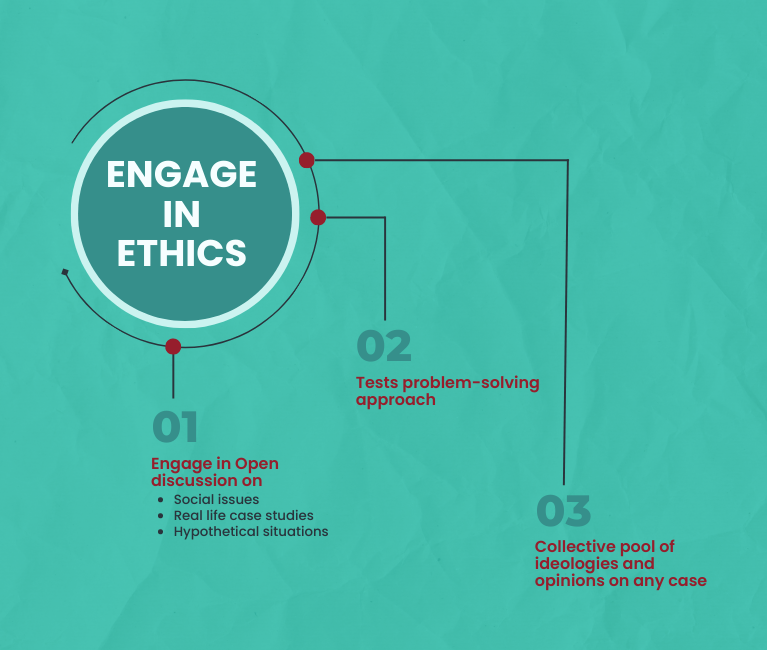
Social Justice
Nai Chetna-Pahal Badlav Ki
For Prelims: Nai Chetna Campaign, Kudumbashree Mission, National Rural Livelihood
For Mains: Nai Chetna Campaign, Kudumbashree Mission, National Rural Livelihood, Causes of Gender Based Violence, Measures to Eliminate Gender Based Violence
Why in News?
Recently, the Ministry of Urban Development launches the “Nai Chetna-Pahal Badlav Ki”- A Community-led National Campaign Against Gender-Based Discrimination.
- Kerala also launched the campaign under the umbrella of the Kudumbashree Mission.
What is the Nai Chetna-Pahal Badlav Ki Campaign?
- About:
- It is a four-week campaign, aiming at equipping women to recognise and prevent violence and making them aware of their rights.
- Activities will be centred on the theme of ‘Gender equality and gender-based violence.’
- Aim:
- This will be an annual campaign focussing on specific gender issues each year. The focus area of the campaign this year is gender-based violence.
- Implementing Agency:
- This campaign will be implemented by all states in collaboration with Civil Society Organisations (CSO) partners, and actively executed by all levels including the states, districts and blocks, engaging the community institutions along with the extended community.
- Significance:
- The campaign will bring together all line departments and stakeholders to create a concerted effort in acknowledging, identifying and addressing the issues of violence.
What is the Kudumbashree Mission?
- It is the poverty eradication and women empowerment programme implemented by the State Poverty Eradication Mission (SPEM) of the Government of Kerala.
- The name Kudumbashree in Malayalam language means ‘Prosperity of the Family’. The name represents ‘Kudumbashree Mission’ or SPEM as well as the Kudumbashree Community Network.
What is the National Rural Livelihoods Mission?
- About:
- It is known as “Deendayal Antyodaya Yojana-National Rural Livelihood Mission (DAY-NRLM)”.
- It is a centrally sponsored programme, launched by the Ministry of Rural Development in June 2011.
- The government accepted the recommendation of the Prof. Radhakrishna Committee and restructured “The Swarnjayanti Gram SwarozgarYojana (SGSY)” into “National Rural Livelihoods Mission (NRLM)” in FY 2010-11.
- Aim:
- To reduce poverty by enabling the poor households to access gainful self-employment and skilled wage employment opportunities, resulting in appreciable improvement in their livelihoods on a sustainable basis, through building strong grassroots institutions for the poor.
- Sub-Schemes:
- MKSP:
- In order to promote agro-ecological practices that increase women farmers’ income and reduce their input costs and risks, the Mission has been implementing the Mahila Kisan Shashaktikaran Pariyojana (MKSP).
- SVEP and AGEY:
- As part of its non-farm livelihoods strategy, DAY-NRLM is implementing Start-Up Village Entrepreneurship Programme (SVEP) and Aajeevika Grameen Express Yojana (AGEY).
- SVEP aims to support entrepreneurs in rural areas to set up local enterprises.
- AGEY, launched in August 2017, to provide safe, affordable and community monitored rural transport services to connect remote rural villages.
- As part of its non-farm livelihoods strategy, DAY-NRLM is implementing Start-Up Village Entrepreneurship Programme (SVEP) and Aajeevika Grameen Express Yojana (AGEY).
- DDUGKY:
- Deendayal Upadhyaya Grameen Kaushalya Yojana (DDUGKY) aims at building placement-linked skills of the rural youth and placing them in relatively higher-wage employment sectors of the economy.
- RSETIs:
- The Mission, in partnership with 31 Banks and State Governments, is supporting Rural Self Employment Institutes (RSETIs) for skilling rural youth to take up gainful self-employment.
- MKSP:
What are the Major Causes of Gender Based Violence?
- Social/Political/Cultural factors:
- Discriminatory social, cultural or religious laws, norms and practices that marginalize women and girls and fail to respect their rights.
- Gender stereotypes are often used to justify violence against women. Cultural norms often dictate that men are aggressive, controlling, and dominant, while women are docile, subservient, and rely on men as providers. These norms can foster a culture of outright abuse.
- Collapse of family, social and communal structures and disrupted roles within the family often expose women and girls to risk and limit coping mechanisms and avenues for protection and redress.
- Judicial Barriers:
- Lack of access to justice institutions and mechanisms, resulting in a culture of impunity for violence and abuse.
- Lack of adequate and affordable legal advice and representation.
- Lack of adequate victim/survivor and witness protection mechanisms.
- lInadequate legal framework, including national, traditional, customary and religious law, that discriminates against women and girls.
- Individual Barriers:
- Threat or fear of stigma, isolation and social exclusion and exposure to further violence at the hands of the perpetrator, the community or the authorities, including arrest, detention, ill-treatment and punishment.
- Lack of information about human rights and on how and where to seek remedies.
What are the Impacts of Violence Against Women?
- It seriously affects all aspects of women’s health- physical, sexual and reproductive, mental and behavioural health, thus preventing them from realizing their full potential.
- Violence and threat of violence affects women’s ability to participate actively, and as equals, in many forms of social and political relationships
- Workplace harassment and domestic violence has an impact on women’s participation in the workforce and their economic empowerment.
- Sexual harassment limits the educational opportunities and achievements of girls.
What can be done to Eliminate Gender Based Violence?
- Gender Based Violence (GBV) can be eliminated through collective efforts of society, government and individuals.
- Training healthcare providers to recognize and respond to gender-based violence is one of the most important ways of identifying and assisting victims.
- The media is a key conduit for making GBV visible, advertising solutions, informing policy-makers and educating the public about legal rights and how to recognize and address GBV.
- School systems are instrumental to stopping GBV before it starts. Regular curricula, sexuality education, school counseling programs and school health services can all convey the message that violence is wrong and can be prevented.
- A number of studies have shown that involving entire communities in recognizing, addressing and working to prevent GBV is one of the surest ways of eliminating it.
UPSC Civil Services Examination, Previous Year Question (PYQ)
Q. We are witnessing increasing instances of sexual violence against women in the country. Despite existing legal provisions against it, the number of such incidences is on the rise. Suggest some innovative measures to tackle this menace. (2014)


International Relations
4th India-France Annual Defense Dialogue
For Prelims: 4th India-France Annual Defense Dialogue, India-France Military Exercises, International Solar Alliance.
For Mains: Effect of Policies & Politics of Countries on India's Interests, India-France Relations
Why in News?
Recently, the 4th India-France Defense Dialogue was held in India.
What are the Key Highlights?
- Defence Industrial Cooperation:
- Both countries discussed Defence Industrial Cooperation with a focus on ‘Make in India’.
- A wide range of bilateral, regional and defence industrial cooperation issues were discussed during the dialogue.
- Military-to-Military Cooperation:
- Both sides reviewed the ongoing military-to-military cooperation, which has increased substantially in recent years.
- They recognised their convergences on a number of “strategic and defence issues and shared the commitment to work together on enhancing cooperation in bilateral, regional and multilateral fora, with a focus on the Indo-Pacific region.
- Indian Ocean Region:
- The discussions ranged from enhancing cooperation in areas of mutual interest to the maritime challenges in the IOR (Indian Ocean Region).
- France reaffirmed its engagement in the Indo-Pacific and India’s centrality in the French strategy for the region.
- France is the current chair of Indian Ocean Commission (IOC) and Indian Ocean Naval Symposium (IONS) and both countries cooperate closely in these fora.
How has been the India-France Strategic Relations?
- Background:
- France was one of the first countries with which India signed a “strategic partnership” after the end of the Cold War, in January 1998.
- France was one of the very few countries to support India’s decision to test nuclear weapons in 1998.
- Defence Cooperation:
- The three services have regular defence exercises; viz.
- Exercise Shakti (Army)
- Exercise Varuna (Navy)
- Exercise Garuda (Air Force)
- Garuda VII was recently held in Jodhpur, Rajasthan.
- India and France had signed a Euro 7.87 billion inter-governmental agreement (IGA) in 2016 for 36 Rafale multi-role fighter jets in fly-away condition,
- France has delivered 35 Rafale jets to India till July 2022.
- India entered into a contract with a French firm to build six Scorpene submarines in India’s Malegaon dockyards through a technology-transfer arrangement in 2005.
- The two countries also signed the Agreement regarding the Provision of Reciprocal Logistics Support.
- This agreement will help to facilitate the replenishment of fuel, rations, spares, and berthing and maintenance for the other nations’ warships, military aircraft and troops during routine port calls, as well as during Humanitarian Assistance and Disaster Relief (HADR).
- The three services have regular defence exercises; viz.
- Indian Ocean, the Common Shared Interest:
- France needs to protect its colonial territorial possessions like reunion island and Indian ocean being the zone of influence for India.
- In 2020, France became the 23rd member of the Indian Ocean Rim Association (IORA).
- It is the first time that a country whose mainland is not on the Indian Ocean has been brought into the fold of the IORA.
- Counter Terrorism:
- France backed the India’s proposal for a global conference on terrorism. Both the countries also support organising a new “No Money for Terror” - an International Conference on Fighting Terrorist Financing.
- France Backing India:
- France also continues to steadfastly back India on Kashmir while its relations with Pakistan have plummeted in the recent past and China has become an object of suspicion.
- Bilateral trade and Economic relations:
- The India-France Administrative Economic and Trade Committee (AETC) provides an appropriate framework to assess and find ways to further promote bilateral trade and investment as well as to speed up the resolution of market access issues to the benefit of economic operators
- France is the 11th largest foreign investor in India with a cumulative investment of USD 10.31 billion from April 2000 to June 2022 which represents 1.70% of the total FDI inflows into India according to statistics provided by the Department for Promotion of Industry and Internal Trade (DPIIT).
- Aeronautics account for 50% of France’s total exports to India. French imports from India have also increased by 39% year-on-year (7% compared to 2019).
- Global agendas:
- Climate change, biodiversity, renewable energy, terrorism, cybersecurity and digital technology, etc:
- There have been joint efforts to limit climate change and develop the International Solar Alliance.
- Both countries have agreed on a road map on cybersecurity and digital technology.
- Space:
- France has agreed to be part of India's Venus mission, scheduled for 2025.
- ISRO’s Venus instrument, VIRAL (Venus Infrared Atmospheric Gases Linker) has been co-developed by Russian and French agencies.
Way Forward
- France, which has valued independent foreign policy, are natural partners in building the new coalitions for an uncertain era.
- France opens the pathway for deeper engagement with Europe on global issues, especially after uncertainty in the region due to BREXIT.
- The new partnerships with France, Germany and other like-minded countries like Japan would hopefully turn out to be far more consequential for India’s influence on the global stage.


Important Facts For Prelims
Himalayan Yak
Why in News?
The Food Safety and Standard Authority of India (FSSAI) has approved the Himalayan Yak as a ‘food animal’.
- The move is expected to help check decline in the population of the high-altitude bovine animal by making it a part of the conventional milk and meat industry.
- Food Animals are those that are raised and used for food production or consumption by humans.
What are the Key Facts of Himalayan Yak?
- About:
- The Yak belongs to the Bovini tribe, which also includes bison, buffaloes, and cattle. It can tolerate temperatures as low as-40 degrees Celsius.
- Adapted for living at high altitudes, they have long hair that hangs off their sides like a curtain, sometimes touching the ground.
- Yaks are highly valued by Himalayan peoples. According to Tibetan legend, the first yaks were domesticated by Tibetan Buddhism founder Guru Rinpoche.
- They are also known as the lifeline of pastoral nomads in high altitudes of the Indian Himalayan region.
- Yaks are traditionally reared under a transhumance system which is primitive, unorganised and full of hardship.
- The Yak belongs to the Bovini tribe, which also includes bison, buffaloes, and cattle. It can tolerate temperatures as low as-40 degrees Celsius.
- Habitat:
- They are endemic to the Tibetan Plateau and the adjacent high-altitude regions.
- Yaks are most comfortable above 14,000 feet. They climb to an elevation of 20,000 feet when foraging and usually don't descend any lower than 12,000 feet.
- The yak-rearing states of India are Arunachal Pradesh, Sikkim, Uttarakhand, Himachal Pradesh and Jammu & Kashmir.
- They are endemic to the Tibetan Plateau and the adjacent high-altitude regions.
- Population in India:
- The countrywide population trend shows that the yak population has been decreasing at an alarming rate. According to a census in 2019, India has some 58,000 yaks – a drop of about 25% from the last livestock census conducted in 2012.
- This drastic decline could be attributed to less remuneration from the bovid, discouraging the younger generations from continuing with nomadic yak rearing.
- It is mainly because yak milk and meat are not a part of the conventional dairy and meat industry, their sale is limited to local consumers.
- The countrywide population trend shows that the yak population has been decreasing at an alarming rate. According to a census in 2019, India has some 58,000 yaks – a drop of about 25% from the last livestock census conducted in 2012.
- Significance:
- The yak plays a multidimensional socio-cultural-economic role for the pastoral nomads who rear it mainly for earning their nutritional and livelihood security due to the lack of other agricultural activity in the higher reaches of the Himalayan region where it is difficult for animals except the yak to survive.
- Threats:
- Climate Change:
- The increasing trend of environmental temperature at high altitudes is resulting in heat stress in yak during warmer months of the year. This, in turn, is affecting the rhythms of physiological responses of the animal.
- Inbreeding:
- As wars and conflicts have led to the closing of borders, the yaks outside borders are thought to be suffering from inbreeding due to the lack of availability of new yak germplasm from the original yak area.
- Climate Change:
- Protection Status of Wild Yak (Bos mutus):
- IUCN Red list status: Vulnerable
- IUCN considers the wild species of yak under Bos mutus, while the domestic form is considered under Bos grunniens.
- CITES: Appendix I
- Indian WildLife (Protection) Act of 1972: Schedule I
- IUCN Red list status: Vulnerable

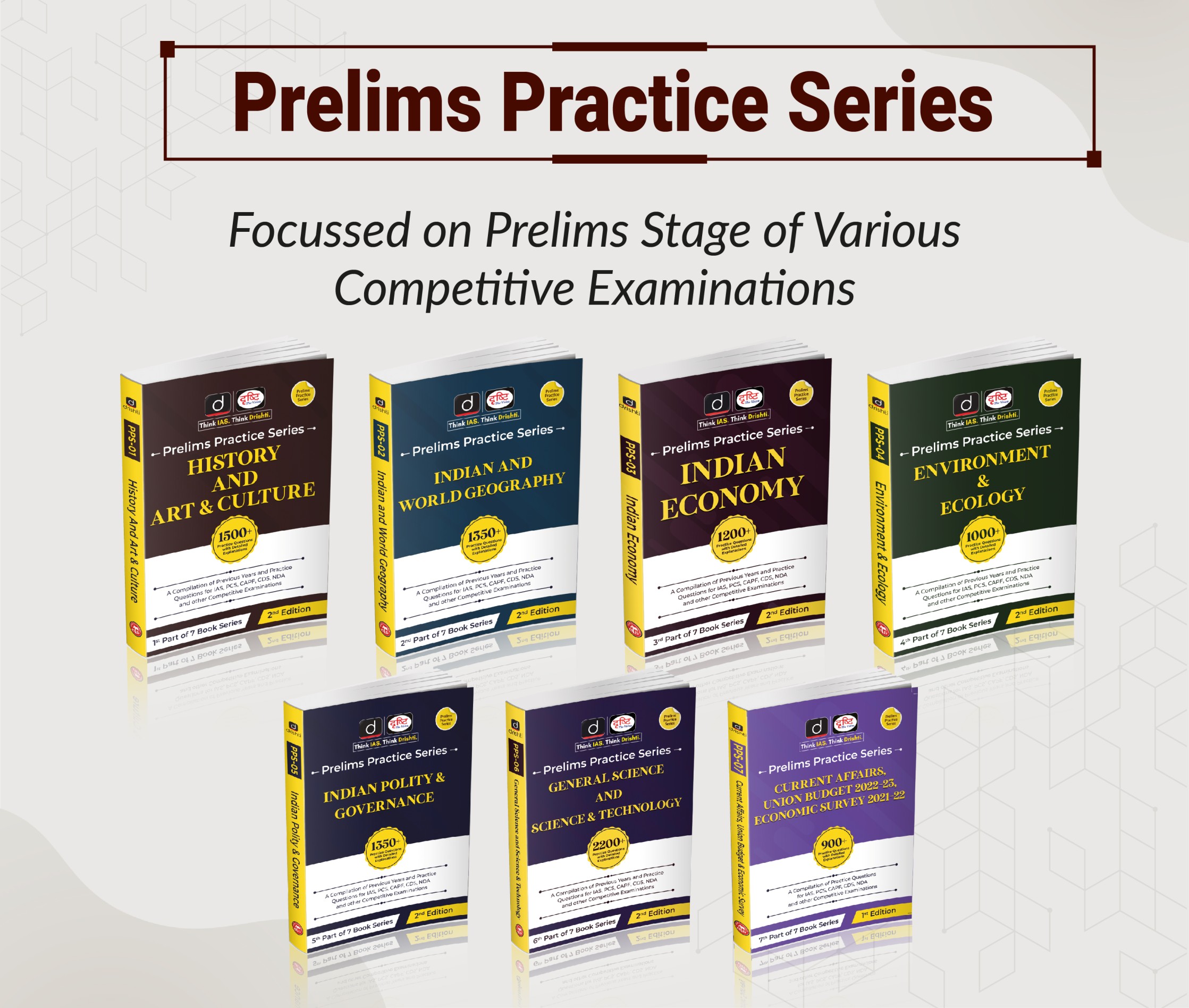
Important Facts For Prelims
Black Corals
Why in News?
Recently, some researchers have discovered five new species of Black Corals living as deep as 2,500 feet (762 metres) below the surface in the Great Barrier Reef and Coral Sea off the coast of Australia.
What are Black Corals?
- Black corals (Anthozoa: Antipatharia) can be found growing both in shallow waters and down to depths of over 26,000 feet (8,000 metres), and some individual corals can live for over 4,000 years.
- However, the taxonomy of black corals is poorly known compared to many other anthozoan groups
- Many of these corals are branched and look like feathers, fans or bushes, while others are straight like a whip.
- Unlike their colourful, shallow-water cousins that rely on the sun and photosynthesis for energy, black corals are filter feeders and eat tiny zooplankton that are abundant in deep waters.
- Similarly, to shallow-water corals that build colourful reefs full of fish, black corals act as important habitats where fish and invertebrates feed and hide from predators in what is otherwise a mostly barren sea floor. For example, a single black coral colony researchers collected in 2005 off the coast of California, United States, was home to 2,554 individual invertebrates.
What are Coral Reefs?
- About:
- Corals are marine invertebrates or animals which do not possess a spine. In scientific classification, corals fall under the phylum Cnidaria and the class Anthozoa.
- Coral is made up of genetically identical organisms called polyps. These polyps have microscopic algae called zooxanthellae living within their tissues.
- The corals and algae have a mutualistic relationship.
- The coral provides the zooxanthellae with the compounds necessary for photosynthesis.
- In return, the zooxanthellae supply the coral with organic products of photosynthesis, like carbohydrates, which are utilized by the coral polyps for synthesis of their calcium carbonate skeletons.
- In addition to providing corals with essential nutrients, zooxanthellae are responsible for the unique and beautiful colors of corals.
- They are also called the “rainforests of the seas”.
- Further, they are of two types:
- Hard corals:
- They extract calcium carbonate from seawater to build hard, white coral exoskeletons.
- Hard corals produce a rigid skeleton made of calcium carbonate (CaCO3) in a crystal form called aragonite.
- They are the primary reef-building corals. Hard corals that form reefs are called hermatypic corals.
- Soft Corals:
- Soft coral does not produce a rigid calcium carbonate skeleton and do not form reefs, though they are present in a reef ecosystem.
- Soft corals are also mostly colonial; what appears to be a single large organism is actually a colony of individual polyps combined to form a larger structure. Visually, soft coral colonies tend to resemble trees, bushes, fans, whips, and grasses.
- Hard corals:
- Significance:
- They support over 25% of marine biodiversity even though they take up only 1% of the seafloor.
- The marine life supported by reefs further fuels global fishing industries.
- Besides, coral reef systems generate USD 2.7 trillion in annual economic value through goods and service trade and tourism.
UPSC Civil Services Examination, Previous Year Question (PYQ)
Prelims
Q.1 Which of the following have species that can establish a symbiotic relationship with other organisms? (2021)
- Cnidarians
- Fungi
- Protozoa
Select the correct answer using the code given below.
(a) 1 and 2 only
(b) 2 and 3 only
(c) 1 and 3 only
(d) 1, 2 and 3
Ans: (d)
Exp:
- Symbiosis is a close ecological relationship between the individuals of two (or more) different species.
- The symbiotic association between the invertebrate phylum Cnidaria (Coelenterate) and the unicellular dinoflagellate algae, called zooxanthellae, is very common and symbolises mutualistic interaction. The beautiful colours of coral reefs is due to the different coloured algae symbiotically attached with the coelenterata. Hence, 1 is correct.
- Mycorrhizae are symbiotic relationships that are formed between fungi and plants. The fungi colonize the root system of a host plant, providing increased water and nutrient absorption capabilities while the plant provides the fungus with carbohydrates formed from photosynthesis. Hence, 2 is correct.
- Symbiosis in protozoa mostly represents a close mutualistic association between a protozoan and unicellular symbionts (bacteria, cyanobacteria or/ and unicellular algae) or protozoans and a multicellular organism (ruminants, lower termites, wood-eating cockroaches and plants).
- Termites have a mutualistic relationship with protozoa that live in the insect’s gut. The termite benefits from the ability of bacterial symbionts within the protozoa to digest cellulose. The termite itself cannot do this, and without the protozoa, it would not be able to obtain energy from its food (cellulose from the wood it chews and eats). Hence, 3 is correct.
- Therefore, option (d) is the correct answer.
Q.2 Consider the following statements: (2018)
- Most of the world’s coral reefs are in tropical waters.
- More than one-third of the world’s coral reefs are located in the territories of Australia, Indonesia and Philippines.
- Coral reefs host far more number of animal phyla than those hosted by tropical rainforests.
Which of the statements given above is/are correct?
(a) 1 and 2 only
(b) 3 only
(c) 1 and 3 only
(d) 1, 2 and 3
Ans: (d)
Q.3 Which of the following have coral reefs? (2014)
- Andaman and Nicobar Islands
- Gulf of Kachchh
- Gulf of Mannar
- Sunderbans
Select the correct answer using the code given below:
(a) 1, 2 and 3 only
(b) 2 and 4 only
(c) 1 and 3 only
(d) 1, 2, 3 and 4
Ans: (a)
Mains
Q. Assess the impact of global warming on the coral life system with examples. (2019)


Important Facts For Prelims
Red Planet Day
Why in News?
28th November is marked as Red Planet Day commemorating the day when National Aeronautics and Space Administration (NASA) mission Mariner 4 was launched in 1964.
- Mariner 4 captured significant information on, and photographs of, Mars for the first time.
What are the Key Points Related to Mars?
- Size and Distance:
- It is the fourth planet from the Sun and the second-smallest planet in the Solar System.
- Mars is about half the size of Earth.
- Similarity to the Earth (Orbit and Rotation):
- As Mars orbits the Sun, it completes one rotation every 24.6 hours, which is very similar to one day on Earth (23.9 hours).
- Mars' axis of rotation is tilted 25 degrees with respect to the plane of its orbit around the Sun. This is similar to Earth, which has an axial tilt of 23.4 degrees.
- Mars has distinct seasons like Earth, but they last longer than seasons on Earth.
- Martian days are called sols—short for ‘solar day’.
- Other Features:
- The reason Mars looks reddish is due to oxidation or rusting of iron in the rocks, and dust of Mars. Hence it is also called the Red Planet.
- It has the largest volcano in the solar system i.e., Olympus Mons.
- It has two small moons, Phobos and Deimos.
What are the Various Mars Missions?
- NASA has a lander (Mars Insight), two rovers (Curiosity and Perseverance), and three orbiters (Mars Reconnaissance Orbiter, Mars Odyssey, MAVEN)
- ExoMars rover (2021) (European Space Agency)
- Tianwen-1: China's Mars Mission (2021)
- UAE’s Hope Mars Mission (UAE’s first-ever interplanetary mission) (2021)
- India’s Mars Orbiter Mission (MOM) or Mangalyaan (2013)
- Mars 2 and Mars 3 (1971) (Soviet Union)
UPSC Civil Services Examination Previous Year Questions (PYQs)
Q1. “The experiment will employ a trio of spacecraft flying in formation in the shape of an equilateral triangle that has sides one million kilometres long, with lasers shining between the craft.” The experiment in question refers to (2020)
(a) Voyager-2
(b) New Horizons
(c) LISA Pathfinder
(d) Evolved LISA
Ans: (d)
Exp:
- Evolved Laser Interferometer Space Antenna (eLISA) is a spectacular plan of setting into space three spacecrafts, a mother and two daughter spacecrafts, which will fly in a triangular formation, trailing the earth in its orbit around the sun at a distance of over 50 million km. Each arm of the imaginary triangle, from the mother to each daughter spacecraft, will measure about a million km.
- eLISA seeks to measure gravitational waves in the frequency range from 0.1 mHz to about 100 mHz. To achieve this, it is necessary for the interferometers to have an arm length of a million kilometres and that is impossible to achieve with an earth based setup.
- Hence, option D is the correct answer.
Q2. Consider the following statements: (2016)
The Mangalyaan launched by ISRO
- is also called the Mars Orbiter Mission
- made India the second country to have a spacecraft orbit the Mars after USA
- made India the only country to be successful in making its spacecraft orbit the Mars in its very first attempt
Which of the statements given above is/are correct?
(a) 1 only
(b) 2 and 3 only
(c) 1 and 3 only
(d) 1, 2 and 3
Ans: (c)
Exp:
- Mangalyaan, launched by ISRO to study maritian surface and atmosphere, is also called Mars OrbiterMission. It is India’s first interplanetary mission. Hence, statement 1 is correct.
- It has been configured to carry out observation of physical features of Mars and carry out a limited study of the Martian atmosphere with following five payloads:
- Mars Colour Camera (MCC)
- Thermal Infrared Imaging Spectrometer (TIS)
- Methane Sensor for Mars (MSM)
- Mars Exospheric Neutral Composition Analyser (MENCA)
- Lyman Alpha Photometer (LAP)
- India is the only 4th country after the USA, Russia and Europe to have a spacecraft orbiting the Mars. Hence, statement 2 is not correct.
- India is the only country to successfully make its spacecraft enter Mars orbit in a single attempt. Hence, statement 3 is correct.
- Therefore, option (c) is the correct answer.


Important Facts For Prelims
SARAS 3 Telescope and Clues to First Stars
Why in News?
Recently, by using the SARAS-3 Radio Telescope, scientists have determined the properties of a radio luminous galaxy that was formed just 200 million years after the Big Bang, a period known as the Cosmic Dawn.
- Researchers have used data from SARAS 3 to throw light on the energy output, luminosity, and masses of the first generation of galaxies that are bright in radio wavelengths.
What are the Findings?
- The new information on the period Cosmic Dawn gave an insight into the properties of the earliest radio loud galaxies that are usually powered by supermassive black holes.
- SARAS 3 had improved the understanding of astrophysics of Cosmic Dawn by telling astronomers that less than 3% of the gaseous matter within early galaxies was converted into stars, and that the earliest galaxies that were bright in radio emission were also strong in X-rays, which heated the cosmic gas in and around the early galaxies.
What is SARAS-3 Radio Telescope?
- SARAS is a niche high-risk high-gain experimental effort of RRI (Raman Research Institute).
- SARAS-3 was deployed over Dandiganahalli Lake and Sharavathi backwaters, located in Karnataka, in early 2020.
- SARAS aims to design, build and deploy in India a precision radio telescope to detect extremely faint radio wave signals from the depths of time, from our “Cosmic Dawn” when the first stars and galaxies formed in the early Universe.
What are Radio Waves and Radio Telescopes?
- Radio Waves:
- Radio waves have the longest wavelengths in the electromagnetic spectrum. They range from the length of a football to larger than our planet. Heinrich Hertz proved the existence of radio waves in the late 1880s.
- The range of the radio spectrum is considered to be 3 kilohertz up to 300 gigahertz.
- Radio Telescope:
- Radio telescopes collect weak radio light waves, bring it to a focus, amplify it and make it available for analysis.
- They help study naturally occurring radio light from stars, galaxies, black holes, and other astronomical objects.
- These specially-designed telescopes observe the longest wavelengths of light, ranging from 1 millimetre to over 10 metres long. For comparison, visible light waves are only a few hundred nanometers long, and a nanometer is only 1/10,000th the thickness of a piece of paper. In fact, we don’t usually refer to radio light by its wavelength, but by its frequency.



